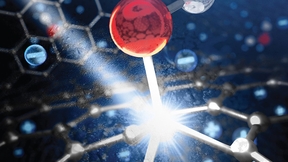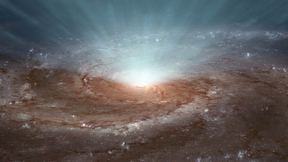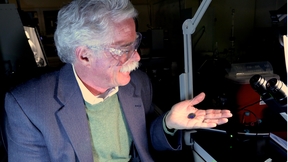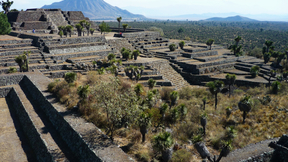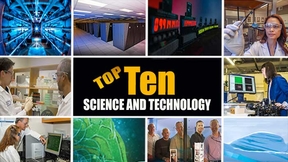Back
Physical and Life Sciences
Study sheds light on elusive warm dense matter
In the last few decades, scientists have been harvesting enormous amounts of data using synchrotron light sources to probe matter at the atomic scale. Now, even brighter light sources have come online — X-ray free-electron lasers. The Linac Coherent Light Source (LCLS) at SLAC National Accelerator Laboratory is one such laser, providing physicists, chemists and biologists…
Lab's Félicie Albert selected as an American Physical Society Outstanding Referee
Félicie Albert, an experimental physicist at Lawrence Livermore National Laboratory, has been selected by the American Physical Society (APS) as an Outstanding Referee for 2015. Outstanding Referees are honored for their exceptional helpfulness in assessing manuscripts for publication in the Physical Review journals.Albert is one of 142 referees selected for recognition in…
Studying effects of target 'tents' on NIF
A systematic study of the effects on National Ignition Facility (NIF) implosions of the ultra-thin mounting membranes that support target capsules inside NIF hohlraums was reported by LLNL researchers in a Physics of Plasmas paper, published online Feb. 4.The performance of NIF’s inertial confinement fusion targets depends on the symmetric implosion of highly compressed…
New research could lead to more efficient electrical energy storage
Lawrence Livermore researchers have identified electrical charge-induced changes in the structure and bonding of graphitic carbon electrodes that may one day affect the way energy is stored.The research could lead to an improvement in the capacity and efficiency of electrical energy storage systems, such as batteries and supercapacitors, needed to meet the burgeoning…
Providing data for nuclear detectives
Fans of the popular TV series "CSI" know that the forensics experts who investigate crime scenes are looking for answers to three key questions: "Who did it; how did they do it; and can we stop them from doing it again?"The field of nuclear forensics, an important element of LLNL’s national security mission, has similar goals and uses similar techniques — but with even…
Research gets to the core of Earth's formation
Violent collisions between the growing Earth and other objects in the solar system generated significant amounts of iron vapor, according to a new study by LLNL scientist Richard Kraus and colleagues.The results show that iron vaporizes easily during impact events, which forces planetary scientists to change how they think about the growth of planets and evolution of our…
Giving shape to black holes' intense winds
By looking at the speed of ambient gas spewing out from a well-known quasar, astronomers are gaining insight into how black holes and their host galaxies might have evolved at the same time.Using the Nuclear Spectroscopic Telescope Array (NuSTAR), researchers were able to use the X-ray spectra of an extremely luminous black hole (quasar PDS 456) to detect a nearly…
Ask this geochemist anything about carbon capture and everything in between
Ever wonder how to use something found in the average kitchen to advance carbon capture and storage technologies, and ultimately save the planet by preventing greenhouse gasses from saturating the atmosphere?Roger Aines, a geochemist who runs the Carbon Fuel Cycle Program at Lawrence Livermore National Laboratory, will be answering questions about capturing greenhouse…
Microcapsules capture carbon safely
Using the same baking soda found in most grocery stores, Lawrence Livermore scientists, along with colleagues from Harvard University and the University of Illinois at Urbana-Champaign, have created a significant advance in carbon dioxide capture.The team developed a new type of carbon capture media composed of core-shell microcapsules, which consist of a highly permeable…
Lawrence Livermore physicist to be inducted into the Alameda County Women's Hall of Fame
A Lawrence Livermore National Laboratory physicist who developed a way to rapidly grow large crystals used in the Lab’s National Ignition Facility (NIF) laser will be honored next month.For her achievements, Natalia Zaitseva will be inducted into the Alameda County Women’s Hall of Fame (WHF) during the 22nd annual awards ceremony on Saturday, March 21. The event, set for…
Claire Max earns astronomical award for providing a clearer view of planets
Claire Max, a longtime astrophysicist at Lawrence Livermore National Laboratory and a faculty member at UC Santa Cruz, has earned the Joseph Weber Award for Astronomical Instrumentation from the American Astronomical Society for her work in adaptive optics (AO).Max co-invented sodium laser guide star adaptive optics and shepherded AO, which takes the "twinkle" out of…
Lawrence Livermore research finds early Mesoamericans affected by climate change
Scientists have reconstructed the past climate for the region around Cantona, a large fortified city in highland Mexico, and found the population drastically declined in the past, at least in part because of climate change.The research appears in the online edition of the Proceedings of the National Academy of Sciences for the week of Jan. 26.Lawrence Livermore researcher…
Humans erode soil 100 times faster than nature
Humans’ use of land, whether for farming or development, has eroded soil 100 times faster than nature working on its own.According to new research in the journal Geology, researchers found that European colonization and agriculture use in North America in the late 1800s and early 1900s caused as much erosion of the landscape over just a few decades' time as would naturally…
Small volcanic eruptions explain warming hiatus
The "warming hiatus" that has occurred over the last 15 years has been caused in part by small volcanic eruptions. Scientists have long known that volcanoes cool the atmosphere because of the sulfur dioxide that is expelled during eruptions. Droplets of sulfuric acid that form when the gas combines with oxygen in the upper atmosphere can persist for many months, reflecting…
Reed elected president-designate of global physics organization
Lawrence Livermore National Laboratory physicist Kennedy Reed has been elected president-designate of the International Union of Pure and Applied Physics (IUPAP).Reed, who was elected at the group’s general assembly meeting held in Singapore in November, is the first American elected to head this global physics organization since Nobel Laureate Burton Richter, who was…
Regina Soufli elected fellow of Optical Society
Physics Division researcher Regina Soufli has been elected a fellow of The Optical Society (OSA). Soufli was cited for her "significant contributions to the development and characterization of extreme ultraviolet, X-ray and gamma-ray optics."Soufli obtained her doctorate in electrical engineering at UC Berkeley and did her doctoral research at the Center for X-ray Optics…
Top 10 science and technology stories of 2014
In 2014, Lawrence Livermore National Laboratory (LLNL) built on a 62-year tradition of translating basic science into technologies that ensure national security, address pressing real world problems and expand the boundaries of fundamental science.The top stories of the year are a reflection of the Laboratory’s ability to apply its core national security competencies to a…
Cells build 'cupboards' to store metals
Lawrence Livermore researchers in conjunction with collaborators at University of California, Los Angeles have found that some cells build intracellular compartments that allow the cell to store metals and maintain equilibrium.Nearly 40 percent of all proteins require metal ions such as zinc, copper, manganese or iron for activity."We don't understand very well how cells…
X-ray laser acts as tool to track life's chemistry
An international research team that includes researchers from Lawrence Livermore National Laboratory has captured the highest-resolution protein snapshots ever taken with an X-ray laser, revealing how a key protein in a photosynthetic bacterium changes shape when hit by light.Human biology is a massive collection of chemical reactions and all involve proteins, known as the…
Webinar to present modeling and simulation capabilities critical for wind power industry
Learn more about Lawrence Livermore National Laboratory’s modeling and simulation capabilities critical for the wind power industry during the next monthly installment of the Industrial Partnerships Office (IPO) Technology & Market Discovery Webinar series, on Tuesday, Dec. 9.The presentation by Lab engineer and wind program leader Wayne Miller, titled "Toolkit for the…





